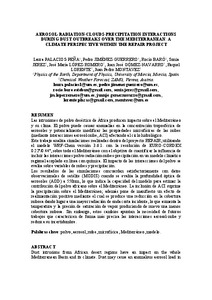Por favor, use este identificador para citar o enlazar este ítem:
http://hdl.handle.net/20.500.11765/9975
Aerosol-radiation-clouds-precipitation interactions during dust outbreaks over the mediterranean: a climate perspective within the repair project
| Título : | Aerosol-radiation-clouds-precipitation interactions during dust outbreaks over the mediterranean: a climate perspective within the repair project |
| Autor : | Palacios Peña, Laura; Jiménez Guerrero, Pedro; Baró, Rocío; Jerez, Sonia; López Romero, José María; Gómez Navarro, Juan José



|
| Palabras clave : | Polvo; Aerosol; Nube; Microfísica; Modelo; Dust; Cloud; Microphysics; Model |
| Fecha de publicación : | 2018 |
| Editor: | Asociación Española de Climatología; Agencia Estatal de Meteorología |
| Citación : | Montávez Gómez, Juan Pedro, et al. (eds.). El clima: aire, agua, tierra y fuego. Madrid: Asociación Española de Climatología; Agencia Estatal de Meteorología, 2018, p. 887-895 |
| Serie/Num. : | Publicaciones de la Asociación Española de Climatología. Serie A;11 |
| Resumen : | [ES]Las intrusiones de polvo desértico de África producen impacto sobre el Mediterráneo y su clima. El polvo puede causar anomalías en la concentración troposférica de aerosoles y potencialmente modificar las propiedades microfísicas de las nubes (mediante interacciones aerosol-nube, ACI) afectando al ciclo hidrológico. Este trabajo analiza simulaciones realizadas dentro del proyecto REPAIR, utilizando el modelo WRF-Chem versión 3.6.1. con la resolución de EURO-CORDEX 0.22º/0.44º, sobre todo el Mediterráneo con el objetivo de cuantificar la influencia de incluir las interacciones polvo-radiación-nubes-precipitación en un modelo climático regional acoplado en línea con química. El impacto de las interacciones del polvo se evalúa sobre variables de nubes y precipitación. Los resultados de las simulaciones concuerdan satisfactoriamente con datos observacionales de satélite (MODIS) cuando se evalúa la profundidad óptica de aerosoles (AOD) a 550nm, lo que indica la capacidad del modelo para estimar la contribución del polvo africano sobre el Mediterráneo. La inclusión de ACI suprime la precipitación sobre el Mediterráneo; además pone de manifiesto un efecto de realimentación positivo mediante el cual se produce una reducción en la cobertura nubosa dando lugar a una mayor radiación de onda corta incidente, lo que aumenta la temperatura y la presión de saturación de vapor produciendo de nuevo una menos cobertura nubosa. Sin embargo, estos cambios apuntan la necesidad de futuros trabajos que caractericen de forma más precisa las interacciones aerosol-nube y reduzca su incertidumbre. [EN]Dust intrusions from African desert regions have an impact on the whole Mediterranean Basin and its climate. Dust may cause an anomalous aerosol load in the tropospheric column and have the potential to modify cloud microphysical properties (by aerosol-cloud interactions, ACI), thus affecting the hydrological cycle. This work analyzes the simulations run in the framework of the REPAIR Project, using the WRF-Chem model version 3.6.1. with the EURO-CORDEX 0.22º/0.44º resolution, over the whole Mediterranean Basin with the objective of quantifying the influence of including dust-radiation-clouds-precipitation interactions in a regional on-line coupled climate/chemistry model. The impact of dust interactions is assessed on several clouds and precipitation variables. Simulation results show a satisfying agreement when compared with satellite observations (MODIS) when assessing aerosol optical depth (AOD) at 550 nm and supports the skills of the model to estimate the African dust contribution over the Mediterranean. The inclusion of ACI suppresses the precipitation over the Mediterranean basin and points out a positive feedback in which the inclusion of ACI from dust produce lower cloud fraction, which results in higher shortwave radiation incoming, also resulting in higher temperatures and higher saturation pressure which produce again a lower cloud fraction. However, the aforementioned changes points to the need for further works to accurately characterize the aerosol-cloud interactions and reduce their uncertainty. |
| Descripción : | Ponencia presentada en: XI Congreso de la Asociación Española de Climatología celebrado en Cartagena entre el 17 y el 19 de octubre de 2018. |
| Patrocinador: | This work was supported by the REPAIR project (CGL2014-59677-R). |
| URI : | http://hdl.handle.net/20.500.11765/9975 |
| ISBN : | 978-84-7837-098-6 |
| Colecciones: | (2018, Cartagena). XI Congreso AEC |
Ficheros en este ítem:
| Fichero | Descripción | Tamaño | Formato | ||
|---|---|---|---|---|---|
| 0080_XI_2018_PALACIOS... | 170,1 MB | Adobe PDF |  Visualizar/Abrir |
Los ítems de Arcimis están protegidos por una Licencia Creative Commons, salvo que se indique lo contrario.





